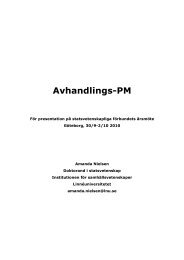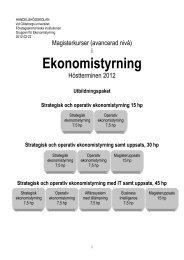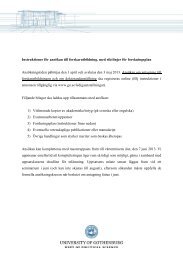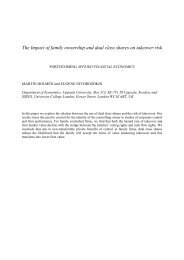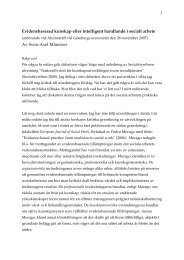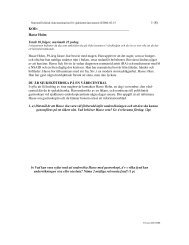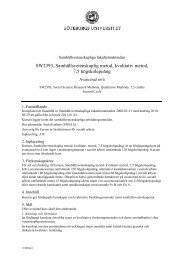Balancing Utilities: Public video surveillance in Sweden
Balancing Utilities: Public video surveillance in Sweden
Balancing Utilities: Public video surveillance in Sweden
Create successful ePaper yourself
Turn your PDF publications into a flip-book with our unique Google optimized e-Paper software.
<strong>Balanc<strong>in</strong>g</strong> <strong>Utilities</strong>: <strong>Public</strong> Video Surveillance <strong>in</strong> <strong>Sweden</strong>(Obs utkast)Fredrika BjörklundInstitutioner för samhällsvetenskaperSödertörns HögskolaStockholmTel. 08 608 4093E-mail: fredrika.bjorklund@sh.sePapper presenterat vid Statsvetenskapliga förbundets årsmöte30 September – 2 Oktober 2010Arbetsgrupp: Policyval vid samhällsförändr<strong>in</strong>g1
policy documents and parliamentary debates. How is privacy def<strong>in</strong>ed, which are theconflict<strong>in</strong>g values presented and what does the solution looks like? I will argue that theSwedish approach can be described as extremely consequentialist; the task presented bySwedish authorities can be summarised as one of balanc<strong>in</strong>g utilities. Accord<strong>in</strong>gly the rightsperspective, i.e. privacy def<strong>in</strong>ed as a right, which is the alternative way of approach<strong>in</strong>g theissue, is rejected. Ultimately this has significance for how the relationship between the stateand the citizen is understood.Certa<strong>in</strong>ly, it is reasonable to ask if this is a specifically Swedish way to attend to public<strong>video</strong> <strong>surveillance</strong>? It will be argued that it is, and that, at least partly, the policy on <strong>video</strong><strong>surveillance</strong> is typical to a protect<strong>in</strong>g state, i.e. a manifestation of a Swedish welfare statelegacy. The close relationship between the political and the judicial “discourse” signifies avalue consensus to the benefit of the Swedish model; and possibly to the detriment of anunbiased debate. In order to substantiate these claims, references are, when applicable, madeto other national contexts and also <strong>in</strong>ternational documents.Privacy and <strong>surveillance</strong> studiesSurveillance studies is today an established academic field; attract<strong>in</strong>g sociologists, lawscholars and to some extent political scientists. To a large extent scholars have, <strong>in</strong>spired byFoucault and his exploration of the perfect prison, the panopticon, focused on <strong>surveillance</strong> asan issue of a new k<strong>in</strong>d of public <strong>in</strong>stitutional control. Another focus is <strong>surveillance</strong> as anexpression of new k<strong>in</strong>ds of social relations. Technological progression creats new conditionsfor state power and for social <strong>in</strong>teraction. Some important works that have to be mentionedare Norris and Armstrong (1999) Lyon, David (2001) Lyon, David (2006) Haggerty andEricson (2006).Often <strong>surveillance</strong> studies do have a normative po<strong>in</strong>t of departure, although it is seldomexpressed explicitly. Certa<strong>in</strong>ly the <strong>in</strong>terest <strong>in</strong> <strong>in</strong>vestigat<strong>in</strong>g the conditions of a new<strong>surveillance</strong> society is spurred by a critical attitude to this phenomenon. This is also true aboutthe specific orientation of <strong>surveillance</strong> studies focus<strong>in</strong>g on value conflicts and the potentialviolation of privacy <strong>in</strong>volved <strong>in</strong> technological supervision. This literature is primarilytheoretical, philosophical and normative. But despite the normative nature of the studies andthe normative nature of the issue as well there are few empirical studies on how privacy, orthe idea of privacy, is actually understood and apprehended <strong>in</strong> different contexts. Workexam<strong>in</strong><strong>in</strong>g the values <strong>in</strong>volved <strong>in</strong> exist<strong>in</strong>g <strong>surveillance</strong> practices has been less frequent. Thereare several policy focused studies on the regulation of privacy, and the <strong>in</strong>ternational efforts <strong>in</strong>3
this field have generated a special <strong>in</strong>terest (Bennet 1992, Rule and Greenleaf 2008, Newman2008). But different approaches to the normative issues are poorly studied, especially on thenational level. Us<strong>in</strong>g a critical idea analytical frame, this is a study on the Swedishcomprehension of the values and normative conflicts <strong>in</strong>volved <strong>in</strong> <strong>surveillance</strong>.The rise of <strong>video</strong> <strong>surveillance</strong> <strong>in</strong> <strong>Sweden</strong>There are no exact figures on the total amount of public <strong>video</strong> <strong>surveillance</strong> cameras <strong>in</strong>stalled<strong>in</strong> <strong>Sweden</strong>, but very likely, <strong>in</strong> 2010, there were more than 50 000 units. <strong>Sweden</strong> is one of thecamera densest countries <strong>in</strong> the world. Video <strong>surveillance</strong> has been used s<strong>in</strong>ce the SecondWorld War, but <strong>in</strong>itially it was exclusively practiced by the security police; <strong>in</strong> detect<strong>in</strong>gpossible violations aga<strong>in</strong>st state security. In the 1970 <strong>video</strong> <strong>surveillance</strong> appeared on thepolitical agenda as a measure of general crime prevention, but <strong>in</strong>itially it was primarily usedby f<strong>in</strong>ancial <strong>in</strong>stitutes and with<strong>in</strong> the bank<strong>in</strong>g sector. It was not until the beg<strong>in</strong>n<strong>in</strong>g of the 20 thcentury that the massive expansion of technological supervision began. Certa<strong>in</strong>ly the Worldtrade centre bomb<strong>in</strong>g and other terror <strong>in</strong>cidents motivated efforts to f<strong>in</strong>d efficient measure tocombat such threats <strong>in</strong> all countries. But it was not as a means <strong>in</strong> the fight aga<strong>in</strong>st terrorismthat <strong>video</strong> <strong>surveillance</strong> should become most salient <strong>in</strong> <strong>Sweden</strong>; <strong>in</strong>stead, supervis<strong>in</strong>g the publicspace with the argument to protect law and order <strong>in</strong> general was a more importantjustification. <strong>Public</strong> spaces such as local communications and stores were <strong>in</strong>creas<strong>in</strong>glyequipped with <strong>video</strong> cameras, later on also schools, taxicabs and public squares. The questsfor <strong>surveillance</strong> were usually impelled, not by state authorities but by private or local<strong>in</strong>itiatives. However, it was not seldom benefited from by the former and therefore also <strong>in</strong> the<strong>in</strong>terest of the state, i.e. the police and the legal system.Despite the massive deployment of cameras, <strong>video</strong> <strong>surveillance</strong> has never been a hot issue<strong>in</strong> the Swedish public debate. The debate dur<strong>in</strong>g the last ten years has been rather modest,both on the Internet and <strong>in</strong> the more traditional mass media, and there is no civil societyorganisation with <strong>video</strong> <strong>surveillance</strong> high on the agenda. In the newspapers the journalistic<strong>in</strong>terest is mostly limited to report<strong>in</strong>g on specific occasions, when for example cameras aredeployed <strong>in</strong> new areas, or the technological progress of the <strong>surveillance</strong> technique; a criticalperspective is seldom raised. One would have expected that the recently establish Pirate party,should have put criticism of the technical visual supervision high on its political program. Theparty set up as a k<strong>in</strong>d of <strong>in</strong>terest organisation <strong>in</strong> matters of the free use of <strong>in</strong>ternet sources,later it took on also general issues of privacy protection; but <strong>video</strong> <strong>surveillance</strong> seems not tobe prioritised as a specific item. Nor has the issue of public <strong>video</strong> <strong>surveillance</strong> <strong>in</strong>spired to any4
Internet activity of the k<strong>in</strong>d that occurred <strong>in</strong> connection with the <strong>in</strong>troduction of the FRA acton phone tapp<strong>in</strong>g <strong>in</strong> 2008.The general public seems, to be fairly contented with the new “security re<strong>in</strong>forc<strong>in</strong>g”measures. The public op<strong>in</strong>ion is fairly affirmative when it comes to technological supervisionof public places. When asked <strong>in</strong> a SOM-<strong>in</strong>vestigation 2009 61 % of the respondents answeredthat they th<strong>in</strong>k that <strong>video</strong> <strong>surveillance</strong> of public places always can be motivated. The positiveanswers have <strong>in</strong>creased s<strong>in</strong>ce 2002 when 47 % argued <strong>in</strong> favour of us<strong>in</strong>g <strong>video</strong> <strong>surveillance</strong>.Also, it is <strong>in</strong>terest<strong>in</strong>g to note that the op<strong>in</strong>ion on <strong>video</strong> <strong>surveillance</strong> deviates from the op<strong>in</strong>ionon other potential <strong>in</strong>tegrity violat<strong>in</strong>g measures, where the public seems to be more sceptical. 1In sum, the attitude to <strong>video</strong> <strong>surveillance</strong> <strong>in</strong> <strong>Sweden</strong> can be characterized with dis<strong>in</strong>terest anda fairly general affirmation.Legal regulation of public <strong>video</strong> <strong>surveillance</strong>While <strong>Sweden</strong> is <strong>in</strong> the forefront when it comes to expansion of <strong>video</strong> <strong>surveillance</strong>, it is alsoahead of most countries <strong>in</strong> legally regulat<strong>in</strong>g the field. Unlike most other countries, there is aspecific legal act on <strong>video</strong> <strong>surveillance</strong>. However, this fact does not automatically mean thatthe legal <strong>in</strong>struments are restrictive concern<strong>in</strong>g when and where <strong>video</strong> <strong>surveillance</strong> ispermitted. Somewhat paradoxically it looks like the read<strong>in</strong>ess to legally regulate goes hand <strong>in</strong>hand with <strong>in</strong>troduc<strong>in</strong>g <strong>video</strong> <strong>surveillance</strong> <strong>in</strong> new social contexts; i. e. the law to a large extentconfirms the already exist<strong>in</strong>g development rather than slows down and restricts anyth<strong>in</strong>g.The Act on public <strong>video</strong> <strong>surveillance</strong> (Lagen om allmän kameraövervakn<strong>in</strong>g 1998:150)came <strong>in</strong>to force <strong>in</strong> 1998. It replaced the former legislation on <strong>video</strong> <strong>surveillance</strong> cameras(Lagen om övervakn<strong>in</strong>gskameror m. m. 1990:484). But the first legal act on TV supervision <strong>in</strong><strong>Sweden</strong> dates back to as early as 1977 (Lagen om TV övervakn<strong>in</strong>g 1977:20). Thetechnological progress <strong>in</strong> the field and its possible implications <strong>in</strong> terms of privacy violationmotivated the revision of the first legal act. 2 In the preparatory works to both the first and thesecond legal act we f<strong>in</strong>d a genu<strong>in</strong>e scepticism towards the implications of the new technology.The risk of misuse was thoroughly discussed, but the idea of possible applications of the newtechnique was rather vague. In the second adjustment, which resulted <strong>in</strong> the current legal act,the word “public” was added to the name of the act, but new arguments were also <strong>in</strong>troduced.Accord<strong>in</strong>g to the Government Bill, the ma<strong>in</strong> <strong>in</strong>tention was to regulate the use of <strong>video</strong><strong>surveillance</strong> so that it could be used as an efficient <strong>in</strong>strument of crime prevention while also1Dagens Nyheter <strong>in</strong>ternet edition 2009 09 302Government Bill 1989/90:1195
<strong>in</strong> a satisfactory way ma<strong>in</strong>ta<strong>in</strong> privacy protection. 3 With the 1998 revision a positive end,crime prevention, was attributed to <strong>video</strong> <strong>surveillance</strong> and its usefulness regarded as avariable to be considered <strong>in</strong> the legal process.The current legal act on public <strong>video</strong> <strong>surveillance</strong> says that <strong>surveillance</strong> of public spaces <strong>in</strong><strong>Sweden</strong> is allowed if certa<strong>in</strong> conditions are met. Normally an authorisation is required by thecounty adm<strong>in</strong>istrative board (Länsstyrelsen). Under certa<strong>in</strong> circumstances, <strong>in</strong> for examplebanks and <strong>in</strong> specified areas <strong>in</strong> stores, no permission is needed; it is sufficient that the boardreceives a notification. There are also exceptions for police <strong>surveillance</strong> with specific aims, aswell as for some other public authorities such as the National Road Adm<strong>in</strong>istration. As a rulethe presence of a camera has to be <strong>in</strong>formed on by a signpost, but some activities are excludedfrom this demand as well. Besides giv<strong>in</strong>g permissions the 21 county adm<strong>in</strong>istrations <strong>in</strong><strong>Sweden</strong> supervise the observance of the law on <strong>video</strong> <strong>surveillance</strong> of public spaces. TheChancellor of Justice may appeal aga<strong>in</strong>st county board decisions <strong>in</strong> the adm<strong>in</strong>istrative court <strong>in</strong>order to protect public <strong>in</strong>terests. 4One legal case worth not<strong>in</strong>g is the Chancellor of Justice’s claim <strong>in</strong> the Adm<strong>in</strong>istrative Courtof Appeal (kammarrätten) <strong>in</strong> 2007 aga<strong>in</strong>st a decision <strong>in</strong> the County Adm<strong>in</strong>istrative Court(länsrätten) concern<strong>in</strong>g the authorisation of polis <strong>video</strong> <strong>surveillance</strong> <strong>in</strong> central Stockholm.The Chancellor of Justice disapproved to grant<strong>in</strong>g the police permission to <strong>in</strong>stall cameras <strong>in</strong> anumber of public places and streets argued by the police to be exposed to high rates of crime.The Adm<strong>in</strong>istrative Court of Appeal dismissed the Chancellor’s argument that the personal<strong>in</strong>tegrity of <strong>in</strong>dividuals was not considered <strong>in</strong> a proper way. The case was eventually appealedto the Supreme Adm<strong>in</strong>istrative Court, but dismissed also <strong>in</strong> this <strong>in</strong>stance. The court concludesthat licens<strong>in</strong>g should, accord<strong>in</strong>g to the preparatory work to the act on <strong>Public</strong> <strong>video</strong>Surveillance, be less restrictive if the purpose is to prevent crimes and accidents. 5S<strong>in</strong>ce 1998 amendments to the current act on <strong>video</strong> <strong>surveillance</strong> have been cont<strong>in</strong>uouslydiscussed. In 2001 the Government <strong>in</strong>itiated an evaluation, which resulted <strong>in</strong> the Video<strong>surveillance</strong> report 6 . Some modifications of the law were asked for <strong>in</strong> the report, for examplethat illegal <strong>video</strong> <strong>surveillance</strong> should lead to compensations. Another suggestion concernedless restrictive restra<strong>in</strong>ts on authorisation of police <strong>video</strong> <strong>surveillance</strong> and <strong>surveillance</strong> by3Government Bill 19997/98:644In addition to the legislation on <strong>surveillance</strong> of public spaces, secret <strong>video</strong> <strong>surveillance</strong> is guided by two otherlegal acts, the Law on secret <strong>video</strong> <strong>surveillance</strong> (Lagen om hemlig kameraövervakn<strong>in</strong>g 1995:1506) and the Lawon compulsory measures (1987:450 Tvångsmedelslagen). However, the practice of these two laws is not <strong>in</strong> focusof this study.5Reger<strong>in</strong>gsrätten mål nr 7873-086Kameraövervakn<strong>in</strong>gsutredn<strong>in</strong>gen, SOU 2002:1106
storeowners. However, the proposals given <strong>in</strong> the report did not guide any revisions of the lawat that time. In 2008 a new expert commission was established with the mandate to look overthe legislation. The report, A new <strong>video</strong> <strong>surveillance</strong> act, was published <strong>in</strong> October 2009; itconta<strong>in</strong>ed suggestions on damages fees for unjustified violation of privacy but alsoprolongation of the admitted time for footage preservation 7 .A comparison between the three consecutive acts on <strong>video</strong> <strong>surveillance</strong> <strong>in</strong>dicates that thelist of exemptions from the requirement on formal permission from the county board havegrown gradually s<strong>in</strong>ce 1977. In practice permissions also <strong>in</strong>creas<strong>in</strong>gly tend to be given moreor less as automatic prolongations of previous authorisations.However, the law on <strong>video</strong> <strong>surveillance</strong> of public spaces does not cover all areas oftechnical supervision of the public. The deployment of cameras <strong>in</strong> so called semi-publicspaces, such as work<strong>in</strong>g places, liv<strong>in</strong>g areas and schools, are not regulated by this legal act.Instead the Personal data act (Personuppgiftslagen 1998:204) is applicable and the SwedishData Inspection Board is the supervis<strong>in</strong>g authority. The Data Inspection Board may demand acorrection if privacy is violated <strong>in</strong> an unjustified way by the film<strong>in</strong>g. But <strong>video</strong> <strong>surveillance</strong> isnot understood as a strict type of personal data registration; as long as the footage is so calledunstructured, which it usually is, there are milder demands than normally prescribed <strong>in</strong> thelaw. The Data Inspection Board impositions may be appealed aga<strong>in</strong>st <strong>in</strong> the adm<strong>in</strong>istrativecourt.One <strong>in</strong>fluential case worth mention<strong>in</strong>g concerns <strong>surveillance</strong> <strong>in</strong> schools. In 2008 the DataInspection imposed the Stockholm School Board to ensure that <strong>in</strong>doors-<strong>video</strong> <strong>surveillance</strong> <strong>in</strong>a secondary school <strong>in</strong> Stockholm was cancelled. The Data Inspection argued that <strong>video</strong><strong>surveillance</strong> was not a proportional measure, when consider<strong>in</strong>g the purpose of supervision,prevent<strong>in</strong>g theft and vandalism, <strong>in</strong> relation to the <strong>in</strong>fliction on the pupils’ <strong>in</strong>terest of a privatesphere. 8 The school board appealed the decision to the County Adm<strong>in</strong>istrative Court withoutsuccess and later on to the Adm<strong>in</strong>istrative Court of Appeal.Actually, Swedish Data protection has a long history. The first Swedish Data act is of earlydate, it orig<strong>in</strong>ates from 1973 and was one of the first acts <strong>in</strong> the world on protection ofprivacy. However, with the European Union Directive 95/46 all EU nations were required toset up data protection acts <strong>in</strong> the late 1990s, and the Swedish act was adjusted to the demandson European coherence. In most countries the national data protection acts are the supremedocuments regulat<strong>in</strong>g <strong>video</strong> <strong>surveillance</strong>, although restriction on footage are found also <strong>in</strong>7En ny kameraövervakn<strong>in</strong>gslag SOU 2009:878Data<strong>in</strong>spektionen Dnr 742-20087
other national legal documents. So, the Swedish Act on <strong>Public</strong> <strong>video</strong> <strong>surveillance</strong> may beregarded as a re<strong>in</strong>forcement of privacy protection <strong>in</strong> this field, a k<strong>in</strong>d of protection that is rare<strong>in</strong> an <strong>in</strong>ternational comparison. <strong>Sweden</strong> has two legal acts applicable to <strong>video</strong> <strong>surveillance</strong>and <strong>in</strong> addition the control function is shared between the Data Inspection Board, which actson the basis of the Personal data act and the county adm<strong>in</strong>istrative boards, bas<strong>in</strong>g theirdecisions on the Act on public <strong>video</strong> <strong>surveillance</strong> 9 .Still, <strong>Sweden</strong> was ranked, by Privacy <strong>in</strong>ternational <strong>in</strong> 2006, as second from the bottomamong EU countries when it comes to attend<strong>in</strong>g to the privacy of its citizens. In the nationalrank<strong>in</strong>g <strong>Sweden</strong> is categorized as a country with “systemic failures to uphold safeguards”. 10Despite extensive legal regulation privacy is still not satisfactorily protected. The Swedishstate on the one hand is fast to regulate, on the other hand, nevertheless, fails to substantiallyguard privacy <strong>in</strong> legal documents.Crime preventionSo <strong>in</strong> fact the issue should rather be turned around, it is not about stricter attention to privacy<strong>in</strong> <strong>Sweden</strong> compared with other countries. The appropriate question is rather: Why is this, <strong>in</strong>an European comparison, weak attendance to privacy <strong>in</strong> <strong>Sweden</strong>? Certa<strong>in</strong>ly, there is morethan one possible explanation to this, but one, which is close at hand, is of course that thereare other values at stake, potentially conflict<strong>in</strong>g with the attendance to privacy, that isregarded as more important. The obvious contest<strong>in</strong>g objective aimed at <strong>in</strong> <strong>video</strong> <strong>surveillance</strong>is the prevention of crimes.As mentioned above, with the 1998 legal act and the preparatory works 11 crime preventionfor the first time was presented an explicit object of <strong>video</strong> <strong>surveillance</strong>. In other words fromnow on the legal regulation on public footage was a direct legal translation of a politicallyexpressed ambition to combat crime with specific means. In fact, the political <strong>in</strong>vestment <strong>in</strong><strong>video</strong> <strong>surveillance</strong> as an efficient means to ga<strong>in</strong> crime prevention was very large. And thelegal regulation transformed <strong>in</strong>to an affirmative document on <strong>in</strong>creas<strong>in</strong>g <strong>video</strong> <strong>surveillance</strong>.But crime prevention is not a completely uncontested ambition <strong>in</strong> this context; and the reasonhas to do with efficiency or rather lack of demonstrated efficiency.9However, this is not obviously the most efficient organisational and legal structure and it has been discussedand criticised from time to time. In fact the public report of 2009, mentioned above, suggested that the overallsupervisionary role should be allocated to the Data Inspection Board <strong>in</strong> order to secure the national uniformity <strong>in</strong>decisions.10www.privacy<strong>in</strong>ternational.org11Government bill 1997/98:648
However, before discuss<strong>in</strong>g the political promotion of <strong>video</strong> <strong>surveillance</strong> as efficient crimeprevention some notes should be made on the concept of prevention. Video <strong>surveillance</strong> isusually categorised as a k<strong>in</strong>d of prevention denoted as situational. The literature discrim<strong>in</strong>atesbetween situation directed measures and socially directed measures of prevention (Zedner2007). While the latter k<strong>in</strong>d of measures concerns improv<strong>in</strong>g social and other conditions forpeople <strong>in</strong> the risk zone of crim<strong>in</strong>ality or car<strong>in</strong>g for former crim<strong>in</strong>als return to a decent life, theformer type of prevention is <strong>in</strong>tended for specific situations where crimes are likely to becommitted. The different k<strong>in</strong>ds of preventions also attend to <strong>in</strong>dividuals, or rather the possibleoffenders <strong>in</strong> different ways. Focus<strong>in</strong>g on situations means focus<strong>in</strong>g on opportunities ratherthan risk groups. By situational prevention the familiar devise “Opportunity makes the thief“becomes a description of reality guid<strong>in</strong>g the practice of crime policy. Offenders are for themost part, deemed to be normal, mundane <strong>in</strong>dividuals who give <strong>in</strong> to temptations as and whencrim<strong>in</strong>al opportunities arise….” (Garland 2000:2) Without argu<strong>in</strong>g on whether this is true orfalse, crime emerges as the outcome of a rational choice that any of us may make, given thatthe risk of detection is small.Accord<strong>in</strong>gly, this implication of <strong>video</strong> <strong>surveillance</strong> as situational prevention imperils acorrespond<strong>in</strong>g generalisation of distrust. With reference to scholars <strong>in</strong> the field, it can beargued that the average citizen is reduced to a potential suspect. (Loodge 2004, Goold 2009).Provided that crime prevention when approached as a public good often is equated with<strong>in</strong>creased security, that is public security, an additional complication turns up. Video<strong>surveillance</strong> is here to enhance peoples’ security <strong>in</strong> a society supposed to be more and moredangerous; i. e. the argument is to protect. But, the protected <strong>in</strong>dividual is also the potentiallysuspected <strong>in</strong>dividual; protection and distrust seems to co<strong>in</strong>cide <strong>in</strong> the state citizen relationship.The term “public” <strong>in</strong> public <strong>video</strong> <strong>surveillance</strong> clearly refer to situational prevention. At thesame time as crime prevention was <strong>in</strong>troduced as the prime aim of <strong>video</strong> <strong>surveillance</strong> thisadditional specification turned up <strong>in</strong> the legal discourse. When <strong>video</strong> <strong>surveillance</strong> was set tobe an important crime preventive measure its field of application was also generalised.Certa<strong>in</strong>ly <strong>in</strong> a way <strong>video</strong> <strong>surveillance</strong> at that time has expanded <strong>in</strong>to a public affair because ofits pure extension, but the term public also opened up for a general use of cameras <strong>in</strong> keep<strong>in</strong>gorder <strong>in</strong> a society composed by <strong>in</strong>dividuals not automatically trusted <strong>in</strong> advance. With thestress on “public” <strong>in</strong> Swedish <strong>video</strong> <strong>surveillance</strong> the generalisation of distrust is accentuated.But public <strong>video</strong> <strong>surveillance</strong> as crime prevention is also <strong>in</strong>volved <strong>in</strong> a general distribution ofsecurity/protection.9
However, several studies, Swedish as well as <strong>in</strong>ternational, has put the merits of <strong>video</strong><strong>surveillance</strong> <strong>in</strong> crime prevention <strong>in</strong>to doubt (Brottsförebyggande rådet: 2003, 2009, Welsh andFarr<strong>in</strong>gton:2007). The general conclusion is that <strong>video</strong> <strong>surveillance</strong> may work under certa<strong>in</strong>specified circumstances and <strong>in</strong> specific locations such as park<strong>in</strong>g places, places with a highlevel of crim<strong>in</strong>ality and on property crimes such as planned burglary. But <strong>video</strong> <strong>surveillance</strong>is, accord<strong>in</strong>g to the Swedish crime prevention board, no universal key to reduce crimes; itworks best <strong>in</strong> comb<strong>in</strong>ation with other measures (Brottsförbyggande rådet 2009). Still, on thepolitical arena, despite the research on the field, prevention has rema<strong>in</strong>ed as a stronglyemphasised argument for <strong>video</strong> <strong>surveillance</strong> 12 . This is so no matter of the political orientationof the government and it has also been an argument widely accepted <strong>in</strong> the parliament dur<strong>in</strong>gthe last ten years. Of course, <strong>in</strong> promot<strong>in</strong>g <strong>video</strong> <strong>surveillance</strong> as crime prevention the not soencourag<strong>in</strong>g research results had to be considered, but nevertheless prevention haspersistently been used as the most important justification. When facts told aga<strong>in</strong>st theprogram, favorable evidence to the contrary has sometimes actively been searched for.Aga<strong>in</strong>st the background of poor results, a public committee (SOU) appo<strong>in</strong>ted <strong>in</strong> 2001 was<strong>in</strong>structed to “consider and deliver suggestions on how camera <strong>surveillance</strong> <strong>in</strong> an efficient andstrategic way could be used <strong>in</strong> crime prevent<strong>in</strong>g efforts”. 13Certa<strong>in</strong>ly the confidence <strong>in</strong> <strong>video</strong> <strong>surveillance</strong> as crime prevention may to some extentexpla<strong>in</strong> a lack of attention to the risk of privacy violation. However, the suggestion here isthat the weak attendance to privacy <strong>in</strong> <strong>Sweden</strong> has to do also with other th<strong>in</strong>g than the simpleassumption that other values, <strong>in</strong> this case crime prevention, outrank privacy; this assumptionhas to be qualified. How privacy is attended to <strong>in</strong> the context of <strong>surveillance</strong> has to do withmore fundamental properties characteris<strong>in</strong>g the values <strong>in</strong>volved and the way they areweighted aga<strong>in</strong>st each other. In this process the idea about privacy, its def<strong>in</strong>ition and urgencyis set.12The <strong>in</strong>structions to evaluation of the law from the M<strong>in</strong>istry of Justice, 2001:53, M<strong>in</strong>ister of Justice B Ask,parliament protocol 2006/07:132, M<strong>in</strong>istry of Justice Instruction 2008:22. Parliament protocol 1997/98:86( Maud Ekendahl (m)), motion bill 1997/98:Ju21 (Gun Hellsvik et.al. (m)), motion bill 1997/98:Ju910 (OlofJohansson et.al. (c)). Parliament protocol 2006/07:1463 (B Ask (m)), Motion bill 2005/06:Ju273 (R Marcel<strong>in</strong>d(kd)), Parliament protocol 2006/07:132 (G Wall<strong>in</strong> (c )), Parliament protocol 2006/07:132 (L Astudillo (s)).Certa<strong>in</strong>ly there were also skeptical voices <strong>in</strong> the parliament, see for example Parliament protocol 1997/98:86(Siv Persson (fp), Kia Andreasson (mp)), motion bill 1997/98:64 (Gudrun Schyman et. al. (v)).13M<strong>in</strong>istry of Justice, Instruction 2001:53, SOU 2002:110, <strong>Public</strong> <strong>video</strong> <strong>surveillance</strong> Allmänkameraövervakn<strong>in</strong>g)10
The balance metaphorFeatur<strong>in</strong>g the Swedish approach is, on the one hand, understand<strong>in</strong>g privacy primarily as aantithesis to someth<strong>in</strong>g else; i.e. to some other value <strong>in</strong> a balance act, on the other hand,dismiss<strong>in</strong>g privacy def<strong>in</strong>ed as a right.Firstly, privacy is seldom mentioned as a self-conta<strong>in</strong>ed and <strong>in</strong>dependent concept. Privacyoccurs almost exclusively as an additional and conflict<strong>in</strong>g value when the objectives of <strong>video</strong><strong>surveillance</strong> are discussed. Privacy is def<strong>in</strong>ed <strong>in</strong> relation to a compet<strong>in</strong>g ga<strong>in</strong> that might beachieved. In the Act on <strong>Public</strong> <strong>video</strong> <strong>surveillance</strong> this relational conception of privacy is<strong>in</strong>scribed <strong>in</strong> the rules on the permitt<strong>in</strong>g procedure:The permit to public <strong>video</strong> <strong>surveillance</strong> must be issued if the value of such <strong>surveillance</strong> weightsheavier than the <strong>in</strong>dividual’s <strong>in</strong>terest of not be<strong>in</strong>g supervised. 14This is what <strong>in</strong> the legal vocabulary goes under the name of “the proportionality pr<strong>in</strong>ciple”;the <strong>surveillance</strong> measures taken have to be proportional to the <strong>in</strong>juries <strong>in</strong>flicted on privacy.The act assumes a conflict between the ga<strong>in</strong>s from public <strong>surveillance</strong> and the <strong>in</strong>dividual’s<strong>in</strong>terest <strong>in</strong> not be<strong>in</strong>g supervised. Privacy, not be<strong>in</strong>g subjected to <strong>surveillance</strong>, serves as anentity possible to put <strong>in</strong>to a calculation where the value of <strong>surveillance</strong> is the other variable.Non of the variables are def<strong>in</strong>ed further, but still, they have to be balanced aga<strong>in</strong>st each other<strong>in</strong> order to decide which one weights heaviest <strong>in</strong> a specific case. The idea of a balance actoccurs frequently <strong>in</strong> public reports and the political debate, but with the variables expressed <strong>in</strong>slightly different ways.Secondly, privacy is, as <strong>in</strong> the legal text above, most commonly def<strong>in</strong>ed as an <strong>in</strong>terest. In thegovernment bill propos<strong>in</strong>g the 1998 legal act, a potential conflict between two <strong>in</strong>terest weresketched; the <strong>in</strong>terest of combat<strong>in</strong>g and <strong>in</strong>vestigat<strong>in</strong>g crimes and the <strong>in</strong>dividual’s <strong>in</strong>terest ofprotection of privacy. In public <strong>video</strong> <strong>surveillance</strong> these two <strong>in</strong>terests must always bebalanced aga<strong>in</strong>st each other. 15 The image of a balance <strong>in</strong>volv<strong>in</strong>g two different <strong>in</strong>terests ispretty popular both <strong>in</strong> documents delivered by the government and the M<strong>in</strong>istry of Justice and<strong>in</strong> the parliamentary debate, 16 but the balance is sometimes also expressed <strong>in</strong> terms ofconflict<strong>in</strong>g needs. Answer<strong>in</strong>g an <strong>in</strong>terpellation <strong>in</strong> the parliamentary debate 2006 on theproposed new law on <strong>video</strong> <strong>surveillance</strong> the M<strong>in</strong>ister of justice argues that14Act on public <strong>video</strong> <strong>surveillance</strong> 1998:150 §6.15Government bill 1997/98:64 Lag om allmän kameraövervakn<strong>in</strong>g.16See for example, the <strong>in</strong>structions to evaluation of the law from the M<strong>in</strong>istry of Justice <strong>in</strong> 2001, and 2008;<strong>in</strong>struction 2001:53 and 2008:22, Parliamentary stand<strong>in</strong>g committee on the adm<strong>in</strong>istration of justice2007/08:JuU8, the parliamentary debate on the government bill, protocol 1997/98:86 (Margareta Sandgren (s)).11
The need for measures and their effects have to be clarified and have to be weighted aga<strong>in</strong>stpeoples opposite needs of protection of privacy. 17The legal establishment, appo<strong>in</strong>ted to safeguard the protection of privacy, also uses the idea ofa balance between needs and <strong>in</strong>terests. For example, <strong>in</strong> a newspaper article <strong>in</strong> November2008, the Chancellor of Justice argued, <strong>in</strong> terms of balances <strong>in</strong>volv<strong>in</strong>g both needs and<strong>in</strong>terests, the need for <strong>surveillance</strong> conflict<strong>in</strong>g with the <strong>in</strong>terest of privacy. The issue of theChancellor’s critical concern was the, to the police favourable, judgement <strong>in</strong> theAdm<strong>in</strong>istrative Court of Appeal on <strong>video</strong> <strong>surveillance</strong> <strong>in</strong> the <strong>in</strong>ner city of Stockholm. 18 We aredisappo<strong>in</strong>ted says the Chancellor of Justice <strong>in</strong> an <strong>in</strong>terview, and had hoped that the courtshould have had another op<strong>in</strong>ion about the balance between the <strong>in</strong>terest of <strong>surveillance</strong> andthe <strong>in</strong>terest of privacy. 19 Later on he followed up his arguments <strong>in</strong> another article <strong>in</strong> the samenewspaper.It is not easy to decide the correct balance between the need for <strong>surveillance</strong> and the <strong>in</strong>terest of aprivate life. Although, accord<strong>in</strong>g to my op<strong>in</strong>ion there is a risk that <strong>surveillance</strong> tempts toshortsightedness and that enough attention isn’t paid to long-term negative effects. 20Interests and needs are variables frequently put <strong>in</strong>to the <strong>surveillance</strong> calculation but the ideaof a balance also turns up <strong>in</strong> other shapes, for example <strong>in</strong> terms of conflict between crimeprevent<strong>in</strong>g effects and privacy violation, 21 or as an issue off efficiency, that is a conflictbetween efficiency <strong>in</strong> crime prevention and the privacy of citizens 22 or <strong>in</strong>nocent citizens 23 .Occasionally, but seldom, a conflict is sketched between <strong>video</strong> <strong>surveillance</strong> and the<strong>in</strong>dividuals right to protection of his/her privacy 24 . In the parliament, somewhat remarkably,the right perspective is represented almost exclusively among left w<strong>in</strong>g deputies.In the act of balanc<strong>in</strong>g privacy and the ga<strong>in</strong>s from supervision are constantly made relativeto each other and sometimes this relativism is drawn even one step further. In the quotationbelow from a speech made by the M<strong>in</strong>ister of Justice, the balance, which usually is presentedas a general estimation is described as an ongo<strong>in</strong>g and case depended process.17Parliament protocol 2006/07:132 (Beatrice Ask M<strong>in</strong>ister of Justice) 12§ Svar på <strong>in</strong>terpellation 2006/07:651om lagen om allmän kameraövervakn<strong>in</strong>g)18Dagens Nyheter 08112619Dagens Nyheter 081107, Interview with Chancellor of Justice Göran Lambertz.20Göran Lambertz, Chancellor of Justice, Dagens Nyheter 081129 Lagen tillåter <strong>in</strong>te dagenskameraövervakn<strong>in</strong>g.21Parliamentary stand<strong>in</strong>g committee on the adm<strong>in</strong>istration of justice, report 1997/98:JuU14, (reservation, SiwPersson (fp)).22Parliament protocol 1997/98:86, (Alice Åström (v))23Motion bill 1997/98:Ju20 (Siw Persson et. al. (fp))24Motion bill 1997/98:Ju22 (Gudrun Schyman et. al. (v))12
The present law on <strong>video</strong> <strong>surveillance</strong> means that a an adjustment between the need forsupervision and the protection of the <strong>in</strong>dividual’s privacy has to be done from case to case…Which <strong>in</strong>terest that weighs heaviest shall not be established once and for all but has to vary fromcase to case. 25With the relativism suggested here privacy is deprived of every form of consistent protection;temporary circumstances may <strong>in</strong>stantly alter the balance.Also the Chief <strong>in</strong>spector at the Data <strong>in</strong>spection subscribed to the balance pr<strong>in</strong>ciple, <strong>in</strong> a ratherrelativistic manner, <strong>in</strong> a newspaper article some year earlier. The fact that the Chief <strong>in</strong>spector,<strong>in</strong> difference to the M<strong>in</strong>ister, is more sceptical to the entire issue, seem to be of lessimportance, when he suggests that he:th<strong>in</strong>ks that all agree to that this expansive field cont<strong>in</strong>uously has to be followed up, put <strong>in</strong>tonorms, be an issue of <strong>in</strong>terest adjustments and exam<strong>in</strong>ed. 26In fact, the idea of a balance is used, not only by <strong>surveillance</strong> advocates, but by all k<strong>in</strong>ds ofcritics to extended <strong>video</strong> <strong>surveillance</strong>. Although, the privacy argument is strong amongcritical columnists, not many <strong>in</strong> total though, <strong>in</strong> the Swedish newspapers, it is <strong>in</strong>terest<strong>in</strong>g tosee that also among them the idea of a balance <strong>in</strong>volv<strong>in</strong>g privacy as one of the variables ispromoted. The utility of <strong>video</strong> <strong>surveillance</strong> is questioned with the argument that;we will loose both privacy and money without necessarily ga<strong>in</strong><strong>in</strong>g <strong>in</strong> crime prevention. 27Certa<strong>in</strong>ly the balance metaphor is a construction where two desirable but seem<strong>in</strong>gly<strong>in</strong>compatible aims, the aim of atta<strong>in</strong><strong>in</strong>g security/crime prevention from <strong>video</strong> <strong>surveillance</strong> andthe aim of privacy, can both be achieved <strong>in</strong> a way that seems less conflict<strong>in</strong>g than it otherwisewould be. By balanc<strong>in</strong>g them there is no need for any choice, both of the aims can be atta<strong>in</strong>edto an appropriate extent. Obviously, the idea of a balance is especially attractive to politicians.In fact, balanc<strong>in</strong>g security and civil liberties, is a universal metaphor widely used <strong>in</strong> both thelegal and the political discourse (Liberatore 2007:114). That is because it is essentially both aneutral and constructive endeavour; nobody can be aga<strong>in</strong>st it. “The term ‘balance’ tends todisarm opponents because it has no tenable antithesis: nobody would stand up and argue forimbalance, or <strong>in</strong>deed for disproportionality”(Ashworth 2007:208).Thus, the proportionality pr<strong>in</strong>ciple is not an exclusively Swedish phenomenon, it is aperspective applied <strong>in</strong> many national contexts. It represents a k<strong>in</strong>d of consequensialistic25Parliament protocol 2006/07:1463 (Beatrice Ask, M<strong>in</strong>ister of Justice)26Göran Gräslund, Chief <strong>in</strong>spector at the Data <strong>in</strong>spection, Dagens Nyheter 050212.27Hanne Kjöller, Dagens Nyheter 080106 Hur kunde något så dyrbart hanteras så billigt? See also Lars WeissDagens Nyheter 081209, Men kamerorna då?13
th<strong>in</strong>k<strong>in</strong>g that is <strong>in</strong>deed widespread <strong>in</strong> the security discourse. In addition, the values <strong>in</strong>volvedare, as <strong>in</strong> the Swedish case, for different reasons, often used <strong>in</strong> an imprecise way - thatbelongs to the political rhetoric. But the idea of a balance is extremely powerful <strong>in</strong> theSwedish case because of the lack of elements of rights reason<strong>in</strong>g. Understand<strong>in</strong>g privacy as aneed or an <strong>in</strong>terest is, <strong>in</strong> fact, understand<strong>in</strong>g it as an utility rather than a right. <strong>Balanc<strong>in</strong>g</strong>utilities aga<strong>in</strong>st one another is much easier than if rights are <strong>in</strong>volved, because the latter havea more <strong>in</strong>violable and absolute character.The Swedish conception of privacyAlthough, most people should agree that the access to privacy is an important aspect of whatis meant by a dignified human life, the precise mean<strong>in</strong>g is not obvious. A commoncomprehension of privacy, i.e. the traditional liberal one, is as a negative right; i. e. the rightto be left alone and not to be <strong>in</strong>terfered with, normally, by the state. This is privacy as aproperty right. S<strong>in</strong>ce this is a rather passive def<strong>in</strong>ition, (see Bennet and Raab:2003 p20f) andpossibly partly outdated <strong>in</strong> the <strong>in</strong>formation era, efforts have been made to qualify the concept,us<strong>in</strong>g more positive terms; privacy is a right to self-control and control over distributed<strong>in</strong>formation about you. This def<strong>in</strong>ition may lead to the conclusion that privacy is a value notonly as an <strong>in</strong>dividual property but also as a political asset; violation of privacy may disturb thefree op<strong>in</strong>ion and eventually also affect the democratic system. (See Schwartz:1999) The basicissue here is whether privacy merely is a value associated to the <strong>in</strong>dividual or if it also is apolitical or social value. The latter is argued by for example Regan (1995).Certa<strong>in</strong>ly an even more fundamental disagreement is whether privacy should be regarded asa right at all. But, before decid<strong>in</strong>g on this issue, the mean<strong>in</strong>g of the concept “right” has to besettled; <strong>in</strong> general there are two ma<strong>in</strong> perceptions. Commonly, rights associate to the naturallaw position on legal practice forcefully advocated by Dwork<strong>in</strong> (2009). In a milder version,speak<strong>in</strong>g about rights we usually th<strong>in</strong>k about someth<strong>in</strong>g that is more or less ultimate,someth<strong>in</strong>g that is costly to violate. This idea of privacy as an absolute right has beendismissed both by legal positivists and communitarians. “Privacy is one good among othergoods and should be weighted as such” Etzioni argues (2007:115). The value of privacy isdependent on the context of the common good. (Etzioni 1999).However, the <strong>in</strong>ternational discourse of conventions and declarations is built on the ideaon human rights and among them privacy is <strong>in</strong>cluded. But, <strong>in</strong> fact us<strong>in</strong>g the word right, <strong>in</strong> thiscontext or <strong>in</strong> ord<strong>in</strong>ary speak<strong>in</strong>g, usually does not mean a clearly formulated op<strong>in</strong>ion on thephilosophical level. This is def<strong>in</strong>itely so also on the arena of national politics. On the other14
hand regardless of whether rights are absolute <strong>in</strong> the philosophical sense, they have thecharacter of values relatively hard to compromise on; at least rhetorically this is the case.Certa<strong>in</strong>ly, privacy understood as a right is such an <strong>in</strong>divisible value, but when the demand onprivacy competes with other desirable aims, it is tempt<strong>in</strong>g to relativise it and make it <strong>in</strong>to avalue more on equal level as other valuable objectives. The Swedish discourse goes even onestep further. Specific to the Swedish context is that privacy does not occur as a right at all.Instead privacy is discussed as a utility on equal foot<strong>in</strong>g as other utilities, that is needs and<strong>in</strong>terests.The Swedish representation of the <strong>surveillance</strong> balance, consist<strong>in</strong>g of <strong>in</strong>terests and needs,can be analysed aga<strong>in</strong>st the background of a broader discursive environment. Certa<strong>in</strong>ly, thespecific conception of privacy reflected <strong>in</strong> the balance construction has its roots <strong>in</strong> Swedishlegal traditions. But, before discuss<strong>in</strong>g this issue, another discursive condition will beaddresses; the peculiarities of the Swedish language.The Swedish language does not conta<strong>in</strong> any specific word for privacy, someth<strong>in</strong>g po<strong>in</strong>ted toby Flaherty (1992) <strong>in</strong> his study from 1992 on privacy and <strong>surveillance</strong> <strong>in</strong> five states.Although, this does not mean that there is no conception of privacy. Mostly <strong>in</strong>tegritet is theword used <strong>in</strong> the Swedish language. Integritet <strong>in</strong>cludes both the English privacy and theEnglish <strong>in</strong>tegrity (decent, honourable). Commonly, it is used synonymously to privacy:sometimes with the supplement personal, i. e. personlig <strong>in</strong>tegritet.Certa<strong>in</strong>ly, l<strong>in</strong>guistic formations affect and <strong>in</strong>teract with the way we th<strong>in</strong>k about differentth<strong>in</strong>gs. But although, the human language <strong>in</strong> a way sets the limits of imag<strong>in</strong>ation, the impactof the lack of the word privacy <strong>in</strong> the Swedish language should not be exaggerated. The realpolitics significance of this condition is not obvious, because there are related expressions athand.But still, it is <strong>in</strong>terest<strong>in</strong>g to notice that the expression used opens up for trad<strong>in</strong>g on theconcept of privacy, i.e. <strong>in</strong>tegritet. Integrity (privacy) and security might be def<strong>in</strong>ed as thesame th<strong>in</strong>g. Subsequently, the conflict between the two can be solved. Thus, the Swedishlanguage embeds a solution to the balance equation. The balance comes out more <strong>in</strong> the formof a paradox rather than represent<strong>in</strong>g a genu<strong>in</strong>e contradiction.The solution to the balance paradox is illustrated by the quotes from a parliament deputybelow. Firstly, security is def<strong>in</strong>ed as part of privacy (den personliga <strong>in</strong>tegriteten), that is, notbe<strong>in</strong>g afraid is an important aspect of privacy.To be able to move around freely is to a very large extent a part of peoples privacy. 2828Motion bill 2007/08 Ju:417 (Luciano Astudillo (s) mfl.) Användn<strong>in</strong>g av övervakn<strong>in</strong>gskameror15
Video <strong>surveillance</strong> <strong>in</strong>creases the possibilities for people to move around freely without be<strong>in</strong>gexposed to threats. Secondly, it is argued that the violation of security i.e. to be a victim ofsevere crime is an important aspect of to the violation of privacy.The most severe violation of privacy is to be exposed to serious crime. 29Almost the same word<strong>in</strong>gs appear <strong>in</strong> a jo<strong>in</strong>t article by the Prosecutor-General, the Nationalpolice commissioner and the Director-General of the Swedish secret security police (SÄPO).To be a victim of crimes or terrorist attacks is an <strong>in</strong>trusion on privacy. 30 The Director of thepublic prosecution authority forces this argument even one step further <strong>in</strong> an <strong>in</strong>terview. Heargues that <strong>video</strong> <strong>surveillance</strong> actually <strong>in</strong>creases privacy because you feel more safe and takencare of. 31 The radical conclusion will be that not deploy<strong>in</strong>g cameras threaten both security andprivacy. A more nuanced way to formulate the issue is to put one k<strong>in</strong>d of <strong>in</strong>tegrity <strong>in</strong>trusionaga<strong>in</strong>st another k<strong>in</strong>d of <strong>in</strong>tegrity <strong>in</strong>trusion. This is the way it is done <strong>in</strong> the <strong>in</strong>structions toevaluation of the law from the M<strong>in</strong>istry of Justice <strong>in</strong> 2001.The privacy (<strong>in</strong>tegrity) <strong>in</strong>trusion that <strong>video</strong> <strong>surveillance</strong> implies has also to be put aga<strong>in</strong>st theprivacy (<strong>in</strong>tegrity) <strong>in</strong>trusion that comes with not be<strong>in</strong>g able to move freely because of fear forbe<strong>in</strong>g exposed to crime. 32Certa<strong>in</strong>ly, obscur<strong>in</strong>g the difference between privacy and security is fundamental tolegitimis<strong>in</strong>g <strong>surveillance</strong>, and it substantially weakens critical arguments. It would be to go tofar to say that view<strong>in</strong>g privacy as identical with security is generally applied, still it ispresented, several times, also <strong>in</strong> statements from the government. The M<strong>in</strong>ister of Justiceargued <strong>in</strong> the follow<strong>in</strong>g manner <strong>in</strong> the parliament <strong>in</strong> 2008:I th<strong>in</strong>k that for the citizens’ security <strong>in</strong> a society with <strong>surveillance</strong> it is important to know whenthere is supervision. 33Of concern here was the need for putt<strong>in</strong>g out signposts where there is a camera deployed <strong>in</strong>order to make people aware of that they are be<strong>in</strong>g watched. Intuitively and most commonlythe demand on signs and transparency belongs to the privacy protection argument. Them<strong>in</strong>ister speaks about security, but security <strong>in</strong> this sentence could be exchanged by privacy29Motion bill 2007/08 Ju:417 (Luciano Astudillo (s) mfl.) Användn<strong>in</strong>g av övervakn<strong>in</strong>gskameror30Fredrik Wersäll, riksåklagare, Stefan Strömberg, rikspolischef, Klas Bergenstrand, generaldirektör, SÄPODagens Nyheter 06 02 11. Sluta måla upp falska bilder av ”övervakarstaten”. Riksåklagaren, rikspolischefenoch Säpochefen: Vi behöver moderna verktyg för att bekämpa den grova brottsligheten.31Intervju med Sven- Erik Alhem, överåklagare. Av Kari Mol<strong>in</strong>, Dagens Nyheter 050819.32The <strong>in</strong>structions to evaluation of the law from the M<strong>in</strong>istry of Justice, 2001:53.33Answer on Interpellation 2007/08:383 Kameraövervakn<strong>in</strong>g (Beatrice Ask, M<strong>in</strong>ister of Justice).16
and the mean<strong>in</strong>g would be the same. The M<strong>in</strong>ister of Justice is not the only one <strong>in</strong> theparliamentary debates to put the argument beh<strong>in</strong>d signs <strong>in</strong> this way. 34There is a built <strong>in</strong> ambiguity <strong>in</strong> the Swedish vocabulary. As said before, the impact of thisambiguity should not be overstated. But, from a discourse analytical po<strong>in</strong>t of view it iscerta<strong>in</strong>ly relevant to the position and quality, of this value <strong>in</strong> Swedish legal acts.Privacy protection is sparsely attended to <strong>in</strong> the Swedish legal framework; <strong>in</strong> addition,when the term privacy (<strong>in</strong>tegritet eller personlig <strong>in</strong>tegritet) occurs its status is weak. Neither<strong>in</strong> the Act on <strong>Public</strong> <strong>video</strong> <strong>surveillance</strong>, nor <strong>in</strong> the Swedish Act on data protection there isanyth<strong>in</strong>g said on the right to privacy. The act on data protection generally avoids mention<strong>in</strong>grights as someth<strong>in</strong>g that may be claimed <strong>in</strong> the context of data protection, the purpose of thelaw is simply said to be to protect people from violation of their personal <strong>in</strong>tegrity. Thus, theSwedish act differs from, and is <strong>in</strong> a way weaker than, correspond<strong>in</strong>g acts <strong>in</strong> other Europeanstates, for example the British and the Polish acts, <strong>in</strong> the way the data subjects are approached.In the latter acts the data subject is a person with rights to protection. In addition the Dataprotection act <strong>in</strong> <strong>Sweden</strong> is a subsidiary law, <strong>in</strong> case of conflicts with another act this actoverrides. This is the case also <strong>in</strong> other countries but, an ambitious <strong>video</strong> <strong>surveillance</strong>regulation policy, such as the Swedish, may <strong>in</strong> fact erode, rather than support, the protectiveambitions of the data protection act.The protection of privacy <strong>in</strong> the Swedish constitution is not very strong when compar<strong>in</strong>gwith other countries. Accord<strong>in</strong>g to 2 chapter 3 § <strong>in</strong> the Instrument of Government Act(reger<strong>in</strong>sformen):Every citizen shall to the extent that is <strong>in</strong> detail stated <strong>in</strong> law be protected aga<strong>in</strong>st violation of hisprivacy by computerised registration of personal <strong>in</strong>formation.Certa<strong>in</strong>ly, the Instrument of Government Act is not an enforceable legal act, it is a guidel<strong>in</strong>efor govern<strong>in</strong>g the state. Chapter 2 is titled Basic freedoms and rights, Still, privacy is nevermentioned as an explicit right and there is also a proviso built <strong>in</strong>to the charter. Protectionaga<strong>in</strong>st violation shall be met to a certa<strong>in</strong> extent <strong>in</strong>formed on <strong>in</strong> other legal acts. A publiccommittee which presented its f<strong>in</strong>al report <strong>in</strong> 2008 35 had as part of the <strong>in</strong>struction to proposeamendments to this paragraph. The suggested amendment concerned <strong>in</strong>creased protectionaga<strong>in</strong>st extensive <strong>surveillance</strong> and mapp<strong>in</strong>g of private circumstances. Still, there would be nogeneral or specified protection of the right to privacy, and whether the suggestion will result34See for example Parliament protocol 2005/06:82 (Johan Pehrson (fp))35Skyddet för den personliga <strong>in</strong>tegriteten Bedömn<strong>in</strong>gar och förslag. Slutbetänkande avIntegritetsskyddskommittén. SOU 2008:3.17
<strong>in</strong> a re<strong>in</strong>forcement of the protection of privacy <strong>in</strong> practice is not clear. However, s<strong>in</strong>ce 1995the European Convention on Human Rights, <strong>in</strong>clud<strong>in</strong>g privacy prescriptions is <strong>in</strong>corporated <strong>in</strong>the Swedish legal system and can be referred to <strong>in</strong> Swedish legal judgements.Compar<strong>in</strong>g the Swedish constitutional rules on privacy with other national constitutionssuch as for example the Polish suggests that privacy is attended to <strong>in</strong> a much more thoroughway <strong>in</strong> the latter constitution. The right to privacy is protected <strong>in</strong> article 47 which states thatEveryone should have the right to legal protection of his private life and family life, of his honourand good reputation and to make decisions about his personal life.Although we f<strong>in</strong>d the idea of proportionality also <strong>in</strong> the Polish constitution, the right toprivacy has a strong position as the ultimate value. Any “limitations shall not violate theessence of freedoms and rights”. 36The Polish Inspector General of data protection is guided by the Polish constitution on rightsto protection of personal data. The Inspector can also, and does so, refer to the Polish CivilCode (Kodeks ciwilny). Article 23 <strong>in</strong> this act states that the personal <strong>in</strong>terests of the humanperson, among them dignity, freedom of conscience, image secrecy of communication<strong>in</strong>violability of home “rema<strong>in</strong> under the protection of civil rights regardless of the protectionprovided <strong>in</strong> other provisions”, while the Swedish data <strong>in</strong>spection board is not guided by anynational legal document explicitly referr<strong>in</strong>g to the right of privacy protection. 37The Polish constitution follows <strong>in</strong>ternational legal documents <strong>in</strong> def<strong>in</strong><strong>in</strong>g privacy asproperty right. In <strong>in</strong>ternational legal frameworks such as the Universal Declaration of HumanRights, the International Covenant on Civil and Political Rights and the European Conventionfor Protection of Human Rights and Fundamental Freedoms privacy is attended to as an<strong>in</strong>dividual property right to be secured from state abuse. In the European convention it is saidthatEveryone has the right to respect for his private and family life, his home and his correspondence.There shall be no <strong>in</strong>terference by a public authority with the exercise of this right except such as is<strong>in</strong> accordance with the law and is necessary <strong>in</strong> a democratic society … 38 .As mentioned before, the property right conception - the right to be let alone- can beopposed to as a passive and atomistic approach mak<strong>in</strong>g privacy <strong>in</strong>to a rather apolitical and36Konstytucja Rzeczypospolitej Polskiej art 31:3.37giodo.gov.pl, data<strong>in</strong>spectionen.se38ECHR art 8 Also the Council of Europe Convention No. 108 for the Protection of Individuals with regard toAutomatic Process<strong>in</strong>g of Personal Data (subscribed by <strong>Sweden</strong> <strong>in</strong> 1983) and The European Union directive 95/46on Data Protection attend to privacy as right.18
defensive value. The German case is <strong>in</strong>terest<strong>in</strong>g because here we f<strong>in</strong>d a clear ambition todef<strong>in</strong>e privacy <strong>in</strong> a positive and substantial way that goes beyond the traditional liberaldef<strong>in</strong>ition found <strong>in</strong> <strong>in</strong>ternational conventions. In 1983 the Federal Supreme ConstitutionalCourt decided to <strong>in</strong>terpret two edicts <strong>in</strong> the constitution; the ‘right to free development ofone’s personality’ and the ‘right to human dignity’ as <strong>in</strong>volv<strong>in</strong>g the right to ‘<strong>in</strong>formationalself-determ<strong>in</strong>ation (<strong>in</strong>formationelles Selbstbestimmung). Everyone has the right to <strong>in</strong>formationon and control over data stored on her or him. The fear of personal <strong>in</strong>formation be<strong>in</strong>g storedshould not h<strong>in</strong>der people to use their basic freedoms and democratic rights. (Kilian 2008:80f).So, a reluctance to consider privacy as a right dist<strong>in</strong>guishes the Swedish approach to thisvalue from the approaches <strong>in</strong> other European states, as well as the <strong>in</strong>ternational discourse onthe issue. Certa<strong>in</strong>ly, it is <strong>in</strong>terest<strong>in</strong>g to discuss the Swedish comprehension as a product of amore distant Swedish legal history. For example, which bear<strong>in</strong>g, if any, do the so calleddoctr<strong>in</strong>e of Uppsala (Uppsalaskolan), very important to the early 20 th century legalestablishment, have on the current discourse? Accord<strong>in</strong>g to this doctr<strong>in</strong>e idealism and absoluterights should be totally dismissed. Besides legal positivism, it also conta<strong>in</strong>ed an utilitarianperspective on the law, imply<strong>in</strong>g that the social good has to be considered <strong>in</strong> law giv<strong>in</strong>g andlaw practice. The doctr<strong>in</strong>e was formed by scholars, who some of them, were more or lessassociated to the social democratic party and their programme had a great impact on thepolicy of this party. Although social democratism may have ceased to be an hegemonicSwedish approach today there is reason to believe that it still has some <strong>in</strong>fluence on theunderstand<strong>in</strong>g of normative issues such as the concern for privacy. Historically, socialdemocracy was less attracted to the idea of liberal <strong>in</strong>dividual rights.In the Swedish legal context violation of privacy is seldom discussed neither as an<strong>in</strong>violable democratic concern nor as an absolute right. In the context of <strong>video</strong> <strong>surveillance</strong> theterm rather signifies a vaguely specified, utility. The utility conception allows for, and evenfacilitates, relativism and thereby re<strong>in</strong>forces the balance approach. By extension the utilityperspective may result <strong>in</strong> that privacy ends up as someth<strong>in</strong>g of a subjective need, that is,another aspect of relativism is <strong>in</strong>volved 39 . The argument on <strong>video</strong> <strong>surveillance</strong> posed by thechancellor of Justice presented below illustrates this turn. In November 2008, when theChancellor appealed <strong>in</strong> the Swedish Supreme Adm<strong>in</strong>istrative Court aga<strong>in</strong>st the affirmativedecision on police <strong>surveillance</strong> <strong>in</strong> the Subord<strong>in</strong>ate Adm<strong>in</strong>istrative Court, he explored his39But the utility approach also opens up for other types of relativism, for example weigh<strong>in</strong>g the needs of amajority aga<strong>in</strong>st the needs of a m<strong>in</strong>ority. As noted by Ashworth: the “practical impact often drifts towards a‘balance’ that <strong>in</strong>volves restrict<strong>in</strong>g the rights of a small m<strong>in</strong>ority <strong>in</strong> the hope of enhanc<strong>in</strong>g the security of themajority” Ashworth 2007:20919
arguments <strong>in</strong> an article <strong>in</strong> a daily paper. Explicitly referr<strong>in</strong>g to the balance between the needfor <strong>surveillance</strong> and the privacy <strong>in</strong>terest, he argued thatThe legal protection of privacy first and foremost concerns those who really feel discomfort with<strong>surveillance</strong>. We who are not affected so much have to remember that. 40Certa<strong>in</strong>ly, equat<strong>in</strong>g the need for protection of privacy with a feel<strong>in</strong>g of discomfort is almostimpossible would privacy be approached as a right. In addition, reduc<strong>in</strong>g privacy to asubjective feel<strong>in</strong>g, does not guarantee this variable a strong position neither <strong>in</strong> this nor <strong>in</strong> anyforthcom<strong>in</strong>g balance acts.However, view<strong>in</strong>g privacy as utility, and not as a right, def<strong>in</strong>itely has consequences for howthis value should be met by the state. Privacy as a utility, an <strong>in</strong>terest or a need, is someth<strong>in</strong>g tobe distributed <strong>in</strong> appropriate proportions to concerned <strong>in</strong>dividuals or groups of <strong>in</strong>dividuals.Rights, on the other hand are someth<strong>in</strong>g to be legitimately claimed aga<strong>in</strong>st the state. In fact,rights have this nature, irrespective of whether they are understood <strong>in</strong> Dwork<strong>in</strong>’s absolutemode or as <strong>in</strong>violable but <strong>in</strong> a less strict sense. Certa<strong>in</strong>ly <strong>in</strong>terests are also to be claimed butthey are not per def<strong>in</strong>ition legitimate <strong>in</strong> the same way as rights.Two Swedish <strong>in</strong>stitutions are especially relevant for claims on privacy violations, the Data<strong>in</strong>spection and the Chancellor of Justice. Both of these <strong>in</strong>stitutions subscribe to the balancepr<strong>in</strong>ciple. They are strongly <strong>in</strong>tegrated <strong>in</strong> the same discursive practice on the utility of privacyas the policymakers <strong>in</strong> the government and <strong>in</strong> the parliament. The Data Inspection is an<strong>in</strong>stitution established to supervise the attendance to privacy and to scrut<strong>in</strong>ize the practice of,among other <strong>in</strong>stitutions, the public adm<strong>in</strong>istration. This mission could be performed <strong>in</strong>different ways, us<strong>in</strong>g different k<strong>in</strong>ds of arguments. The Chief Inspector of the Data Inspectionfully approve to the utility perspective 41 ; subsequently the argument on stronger privacyprotection concerns a heavier weight put on this variable compared with the other values<strong>in</strong>volved <strong>in</strong> the balance equation. Protection of privacy <strong>in</strong> <strong>video</strong> <strong>surveillance</strong> matters meansrem<strong>in</strong>d<strong>in</strong>g about the need for proportionality. There is no qualitative difference <strong>in</strong> theargumentation, i.e. rights versus utility, between the political sphere and the data <strong>in</strong>spection;criticism is a matter of emphasises.Possibly, there are also structural factors <strong>in</strong>volved <strong>in</strong> the Swedish legal-political consensus.It should be noted that the Chief Inspector of the Data Inspection is appo<strong>in</strong>ted by the Swedish40 Göran Lambertz Swedish Chancellor of Justice, Dagens Nyheter 081129. Worth not<strong>in</strong>g is that the Chancellorused the word privatliv (privat life) <strong>in</strong>stead of personal <strong>in</strong>tegrity. Private life is a word not belong<strong>in</strong>g to theSwedish legal context, <strong>in</strong> fact, l<strong>in</strong>guistically it reduces the content of privacy (<strong>in</strong>tegritet) to someth<strong>in</strong>g verylimited.41Göran Gräslund, Chief <strong>in</strong>spector at the Data <strong>in</strong>spection, Dagen Nyheter 081002.20
government. In other countries, such as for example, Germany and Poland, the ChiefInspector of Data protection is appo<strong>in</strong>ted by the parliament; this is someth<strong>in</strong>g that, at leastformally, gives them a stronger position towards the government. However, <strong>in</strong>stitutionalconditions are not the subject of this paper.The welfare state legacy?Supply<strong>in</strong>g security is a traditional field of state competence. In the current more and moreglobally spread security discourse, states have taken on new forms of responsibility for thesafety of people, <strong>in</strong>volv<strong>in</strong>g new types of devices such as <strong>video</strong> <strong>surveillance</strong>. Privacy on theother hand is traditionally someth<strong>in</strong>g that should be protected from state <strong>in</strong>terference. Mak<strong>in</strong>gprivacy and security <strong>in</strong>to equal entities of utility, i.e. <strong>in</strong>clud<strong>in</strong>g them both under the umbrellaof protection, <strong>in</strong>validates the fact that privacy claims are someth<strong>in</strong>g that normally emanatefrom the <strong>in</strong>dividual or the society and are directed aga<strong>in</strong>st the state. In the Swedish caseprivacy is someth<strong>in</strong>g distributed by the state not someth<strong>in</strong>g that should be legitimatelyasserted aga<strong>in</strong>st the state. The Swedish state takes responsibility for both the distribution ofsecurity and the distribution of privacy <strong>in</strong> adequate proportions. The idea of a balancebetween security (crime prevention) and privacy is the metaphorical depiction of theaggregation of different utilities.There are no obvious complications <strong>in</strong> understand<strong>in</strong>g crime prevention/security as apublicly distributed utility. Concern<strong>in</strong>g the concept of privacy it is more complex. Whetherprivacy is a utility, rather than a right, is a matter of academic dispute. International legaldocuments favour the right conception, and this is also the case <strong>in</strong> many, probably mostnational practices <strong>in</strong> democratic states. Without mak<strong>in</strong>g any normative statements it has to beconcluded that the Swedish utility approach weakens the idea of privacy. If privacy isregarded as someth<strong>in</strong>g that should be distributed by the state rather than someth<strong>in</strong>g to belegitimately claimed aga<strong>in</strong>st the state it will <strong>in</strong>evitably have a weaker position.In fact distribution of utilities is the usual way of welfare state policy, by the establishmentof <strong>video</strong> <strong>surveillance</strong> explicitly demanded to <strong>in</strong>clude an additional field of concern – privacy.Guided by the traditional welfare state ambitions, the state is responsible for deliver<strong>in</strong>gprivacy to its citizens <strong>in</strong> the same way as it used to supply for material needs. The discursiveconsensus around the utility perspective, <strong>in</strong>volv<strong>in</strong>g also the legal establishment <strong>in</strong> the fieldmakes the task easier.21
LITERATURE:Ashworth, Andrew (2007). Security, Terrorism and the Value of Human Rights. In Benjam<strong>in</strong> J Gooldand Liora Lazarus (eds), Security and Human Rights. Portland, Or.: Hart Publish<strong>in</strong>g.Bennet, Col<strong>in</strong> J. (1992). Regulat<strong>in</strong>g Privacy Data Protection and <strong>Public</strong> Policy <strong>in</strong> Europe and theUnited States. Ithaca: Cornell University Press.Brottsförebyggande rådet. Kameraövervakn<strong>in</strong>g i brottsförebyggande syfte. Rapport 2003.Brottsförebyggande rådet .Kameraövervak<strong>in</strong>g i Landskrona. En utvärder<strong>in</strong>g. Rapport 2009.Dwork<strong>in</strong>, Ronald (2009, 1977). Tak<strong>in</strong>g Rights Seriously. London: Duckworth.Etzioni, Amitai (1999). The Limits of Privacy. New York: Basic Books.Etzioni, Amitai (2007). Are New Technologies the Enemy of Privacy? Knowledge,Technology and Policy, 20:115-119.Flaherty, David H. (1992) Protect<strong>in</strong>g Privacy <strong>in</strong> Surveillance Societies. The University of NorthCarol<strong>in</strong>a Press.Garland, David (2000). Ideas, Institutions and Situational Crime Prevention. In Andrew vonHirsch, David Garland and Alison Wakefield Ethical and Social Perspectives onSituational Crime Prevention. Oxford: hart Publish<strong>in</strong>g.Goold, Benjam<strong>in</strong>, J. (2009). ”Technologies of <strong>surveillance</strong> and the erosion of <strong>in</strong>stitutional trust”. InKatja Aas et. al. (eds) Technologies of Insecurity: The <strong>surveillance</strong> of Everyday Life. Oxon:Routledge.Haggerty Kev<strong>in</strong> D. and Richard V. Ericson (eds) (2006). The new politics of Surveillance andvisibility. Toronto: University of Toronto Press.Kilian, Wolfgang (2008). Germany. In Global Privacy and Protection: The First Generation, editedby James B. Rule and Graham Greenleaf. Cheltenham: Edward Elgar Publish<strong>in</strong>g. (80-106)Liberatore, Angela (2007). <strong>Balanc<strong>in</strong>g</strong> Security and Democracy, and the Role of Expertise: BiometricsPolitics <strong>in</strong> the European Union European Journal on Crim<strong>in</strong>al Policy and Research 13(1-2), pp109-137.Lodge, Juliet (2003). “EU homeland security: citizens or suspects?”. Journal of European Integration.26(3: 253-279.Lyon, David (2001). Surveillance society: Monitor<strong>in</strong>g everyday life. Buck<strong>in</strong>gman: Open UniversityPress.Lyon, David (2006). Theoriz<strong>in</strong>g Surveillance: The panoticon and beyond. Cullompton Devon: WillianPublish<strong>in</strong>g.Newman, Abraham L. (2008). Protectors of Privacy. Regulat<strong>in</strong>g Personal Data <strong>in</strong> the GlobalEconomy. Ithaca: Cornell University Press.22
Norris, Clive and Gary Armstrong (1999) The Maximum <strong>surveillance</strong> Society: the Rise of CCTV.Oxford, New York: Berg.Regan, Priscilla M. (1995). Legislat<strong>in</strong>g Privacy: Technology, Social Values and <strong>Public</strong> Policy. ChapelHill: University of North Carol<strong>in</strong>a Press.Rule, James B. and Graham Greenleaf (ed) (2008). Global Privacy Protection: The First Generation.Cheltenham: Edward Elgar.Schwartz, Paul M. (1999). Privacy and Democracy <strong>in</strong> Cyberspace. Vanderbilt Law Review, 52:1609-1701.Welsh, B. C. and D. P Farr<strong>in</strong>gton (2007). Kameraövervakn<strong>in</strong>g och brottsprevention: En systematiskforskn<strong>in</strong>gsgenomgång. Stockholm: Brottsförebyggande rådet.Zedner, Lucia (2007). Seek<strong>in</strong>g Security by Erod<strong>in</strong>g Rights: The Side-stepp<strong>in</strong>g of Due Process. InBenjam<strong>in</strong> J Goold and Liora Lazarus (eds), Security and Human Rights. Portland, Or.: HartPublish<strong>in</strong>g.23





